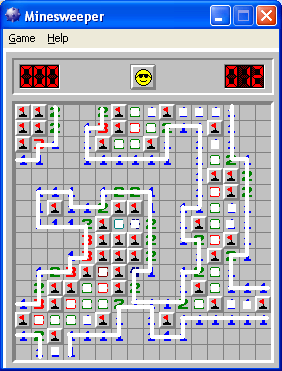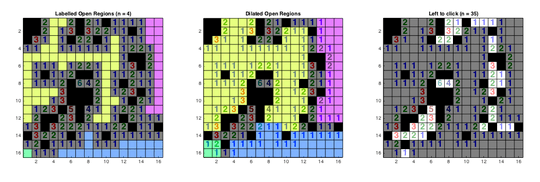17
3
The 3BV of a Minesweeper board represents the minimum number of left clicks required to solve the board if you already know the solution. It stands for "Bechtel's Board Benchmark Value". Here's his site explaining it.
Below is a solved Minesweeper board. The flags indicate mines; tiles without mines indicate the count of adjacent mines, including diagonally, except that tiles that should have "0" are left blank instead. The image shows which tiles need to be clicked in order to solve the board.
Clicks counted towards the 3BV are:
- One for each flood-filled area of blank tiles (zero mines adjacent) and their non-blank neighbors.
- One for each other non-mine tile.
Another Example (3BV = 39)
Given a 2D array of values, 0 for clear and 1 for a mine (or a boolean), return the 3BV.
A board's dimensions will be at least 8x8, and at most 24x30, inclusive. Your program should handle all possible boards, not just the examples.
Note: A board will never contain only mines.
Example I/O:
[[0,0,0,0,0,0,0,0],
[0,0,0,1,0,0,0,0],
[0,0,0,1,0,0,1,0],
[0,1,0,0,1,0,0,0],
[0,0,1,0,0,0,0,1],
[0,0,0,1,0,0,0,0],
[0,0,0,0,0,0,1,0],
[0,0,0,0,0,0,0,1]]
23
[[0,0,1,0,0,0,1,1,0,0,0,0,0,1,0,0,0,1,0,0,0,0,0,1,0,0,1,0,0,0],
[0,0,0,0,0,1,1,1,0,0,1,0,0,0,0,0,0,1,0,0,1,0,1,1,0,0,0,0,0,0],
[0,1,0,0,0,0,1,0,0,1,0,1,0,0,1,0,0,1,0,1,1,0,0,0,1,0,1,0,1,0],
[0,0,0,1,0,0,0,0,0,0,0,0,0,0,0,0,0,0,0,0,0,0,1,0,0,1,1,0,0,0],
[0,0,0,1,0,0,0,0,0,0,0,0,0,1,0,0,0,0,0,0,0,0,0,0,1,0,0,0,0,0],
[0,0,0,0,0,0,0,1,0,0,0,0,0,0,0,0,0,0,0,0,0,1,0,1,0,0,1,1,0,1],
[0,0,0,0,0,1,0,0,0,0,0,0,0,0,0,0,0,0,0,0,0,0,0,1,0,1,0,0,1,1],
[0,0,0,0,0,0,0,0,0,0,1,0,0,0,0,0,0,0,0,0,0,0,0,0,0,1,0,0,0,0],
[0,0,0,0,0,1,0,0,0,0,0,0,0,0,1,0,0,0,0,0,0,0,0,1,0,0,0,0,0,0],
[0,0,1,0,0,0,1,0,0,1,0,0,1,0,0,0,0,0,0,0,1,0,1,0,0,0,1,0,0,0],
[1,0,0,0,0,1,0,0,0,0,0,0,0,0,1,0,0,0,0,0,1,0,0,1,0,0,0,0,1,1],
[0,0,0,0,0,0,0,0,0,0,1,0,0,1,0,0,0,1,1,0,1,1,0,0,0,0,1,1,0,0],
[0,0,0,0,0,1,0,1,1,0,0,0,0,0,0,1,0,1,1,0,0,0,1,0,0,0,1,1,0,0],
[0,1,1,1,0,0,0,0,0,1,0,1,0,0,1,0,0,0,0,0,0,0,0,0,0,0,0,0,1,0],
[0,0,0,1,0,1,0,0,0,0,0,0,0,0,0,1,0,0,1,0,0,1,0,0,0,0,1,0,0,0],
[0,0,1,0,0,0,0,0,0,1,0,0,0,1,0,0,0,0,0,1,0,1,1,0,0,0,0,0,0,0]]
187




Is an array of integers okay as input? Each integer codes one row. – Karl Napf – 2016-06-08T19:21:42.990
@KarlNapf No. The input should be recognizable as a board as shown. – mbomb007 – 2016-06-08T20:20:29.030
Could you provide more test cases, possibly including the input based on the displayed images, and maybe a max dimensions test case? – miles – 2016-06-08T20:47:26.133